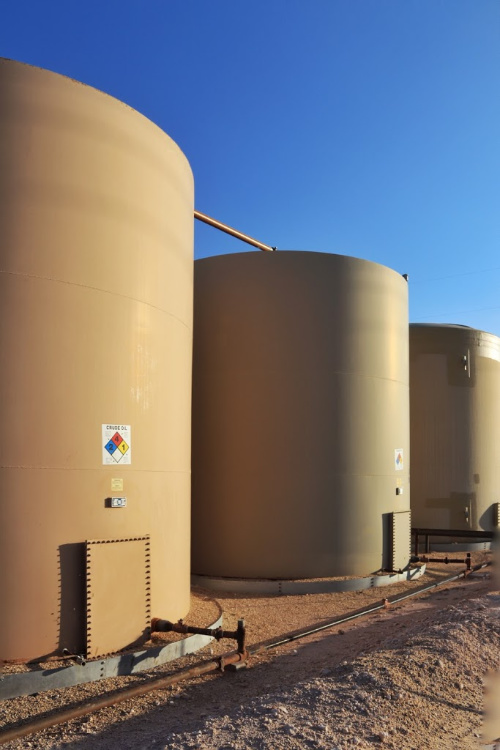
(Source: G B Hart/Shutterstock.com)
[Editor's note: A version of this story appears in the July 2020 edition of E&P. Subscribe to the magazine here. It was originally published July 1, 2020.]
April 2020 marked the beginning of an alarming period for oil executives. WTI crude oil futures entered negative territory for the first time, trading as low as negative $37.63/bbl. With airlines slashing oil purchases after canceling thousands of flights due to the COVID-19 pandemic, along with the oil glut flooding global markets courtesy of the price war between Saudi Arabia and Russia, most U.S. storage tanks remain filled to capacity. Thus, the industry has what was previously unthinkable: holders of futures contracts paying a third party to “take the oil off their hands,” according to one national publication.
“The global market has never in history collapsed as precipitously as it has right now,” opined Daniel Yergin, Pulitzer Prize-winning author and vice chairman of IHS Markit, in a recent article in Foreign Affairs magazine.
Considering the expenses incurred by a perfect storm of loaded storage tanks, an inability to sell at a time when oil prices are hitting lows unseen in more than 40 years and ever-present environmental regulations, now would be an opportune time to take a closer look at developments in tankless operations. Pilot projects, particularly in the Permian Basin, are showing great potential in reducing costs, alleviating environmental issues associated with the tanks and improving profit margins.

Current challenges
COVID-19, the oil-saturated market and freefalling prices at the pump have all contributed to excess supply. Expenses incurred by the nation’s tank farms have worsened as demand hits record lows with little demand for each tank’s 400 to 500 barrels awaiting pumping to a pipeline gathering system or to road tankers. These conditions show no signs of improvement as the industry struggles in this unsettling environment. Current oil production—and that includes shale plays—still requires massive capital outlays and a large footprint.
Part and parcel of the process are the safety and environmental risks of venting hydrocarbons into the atmosphere from each tank. Examples of the former were lightning strikes of tanks in Texas in 2015 and Illinois in 2016, each resulting in extensive damage and property loss. However, environmental concerns from venting natural gas and its greenhouse gases (GHGs) into the atmosphere are no less concerning.
On April 20, 2020, Bloomberg reported on a startling finding from a Harvard and Environmental Defense Fund research study. “Enough gas to supply 7 million homes is leaking into the atmosphere above oil fields in Texas and New Mexico—the largest plume of climate-change-driving methane pollution ever recorded over a U.S. oil field,” according to the report. The study, which generated its findings from satellite data, attributes those leaks to “gas venting and flaring” in the Permian Basin.
As the Bloomberg report noted, insufficient numbers of pipelines and processing equipment leave energy companies no alternative to venting hydrocarbons from the tanks, meaning the introduction of even more methane into the atmosphere, according to the study. Methane has long been identified as a major contributor to global warming and climate change, as are CO2 and H2S, which are among GHGs released via venting.
Substantial environmental improvement data from this pilot project are just one factor among many that indicates the enormous potential of tankless operations for the industry.
These factors contribute to an inescapable need for alternative processing to improve environmental compliance, production output, safety and cost efficiency. One such processing model appears capable of achieving all four objectives, in particular reducing GHG emissions and lowering capital outlays and opex by eliminating the huge and costly footprint of tank farms.
Promise of tankless operations
Process simulations have demonstrated that crude oil can be processed to produce oil that meets sales specifications without the use of tanks. Theory has been put into practice at the Shell pilot project in the Permian Basin in West Texas. Here, fluids (oil, gas and water) from the wells are processed in pressure vessels (separators) where conditions of pressure, temperature and flow are controlled. Oil stability is maintained in two stages, the first in the separator and the second in the heated separator. When those steps are completed, oil is ready to be pumped to midstream companies without the need for storage tanks. Because the oil is stable, only a minimum amount of gas is released, which would be a major step forward toward the elimination of GHGs and assuring compliance with EPA regulations. In its 2019 Sustainability Report, the company said the facility is designed to emit 60% fewer GHGs compared with other shale projects.
Substantial environmental improvement data from this pilot project are just one factor among many that indicates the enormous potential of tankless operations for the industry. Safety has been substantially improved by practically eliminating the possibility of oil spills and fires.
Another benefit is lessening the industrial footprint by eliminating the construction and operation of tank farms. Instead, a central processing facility at the well site controls operations, including pressure vessels and pumping. The absence of storage tanks eliminates the need for construction and maintenance of containment dikes required by storage vessels.
Despite all the projected benefits of the tankless process documented thus far, there is an important concern that must be addressed. It is the impact on production from a separator shutdown, which would interrupt exports to midstream operators until the shutdown cause is corrected and the unit’s processing and pumping operations are restored. The oil producer can choose to build a tank storage buffer at a central processing plant. In this scenario, pumping can continue until inventory in the tank runs oil, which provides a time buffer for repairs. Clearly avoiding and averting conditions that can lead to a separator shutdown are high priorities with or without a storage tank buffer.
Future outlook
The record lows and negative territories of crude oil futures are the proverbial wake-up calls for industry executives. This is not the time to ride things out in the hope that the free market runs its course and the economic situation substantially improves. Expect the possibility of design modifications or simplifications that may well presage a changing focus for the shale plays in the Permian Basin.
With the tankless operations pilot project data showing welcome improvements in cost efficiencies, environmental compliance and operational safety enhancements, the energy industry might be on the verge of delivering a cleaner, safer, less costly and more environmentally responsible means of oil and gas production. It is not an overstatement to suggest that a change in direction must be evaluated and seriously considered not only for reasons of profitability but perhaps for the survival of many producers if the pattern of freefalling prices is not reversed.
Recommended Reading
E&Ps Pivot from the Pricey Permian
2025-02-01 - SM Energy, Ovintiv and Devon Energy were rumored to be hunting for Permian M&A—but they ultimately inked deals in cheaper basins. Experts say it’s a trend to watch as producers shrug high Permian prices for runway in the Williston, Eagle Ford, the Uinta and the Montney.
US Drillers Add Oil, Gas Rigs for First Time in Eight Weeks
2025-01-31 - For January, total oil and gas rigs fell by seven, the most in a month since June, with both oil and gas rigs down by four in January.
Liberty Capitalizing on Power Generation as Completions Stay Flat
2025-01-31 - New Liberty Energy Inc. CEO Ron Gusek says company is ‘uniquely positioned’ to deliver modular units for data centers.
Cummins, Liberty Energy to Deploy New Engine for Fracking Platform This Year
2025-01-29 - Liberty Energy Inc. and Cummins Inc. are deploying the natural gas large displacement engine developed in a partnership formed in 2024.
Comments
Add new comment
This conversation is moderated according to Hart Energy community rules. Please read the rules before joining the discussion. If you’re experiencing any technical problems, please contact our customer care team.



